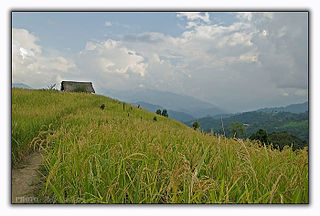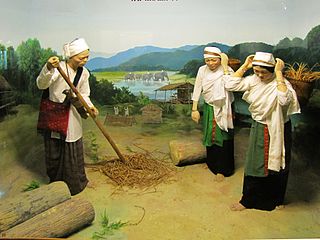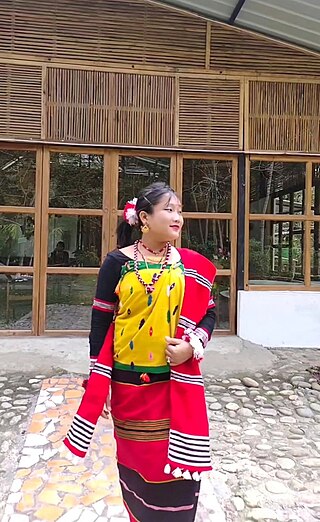Kami are the deities, divinities, spirits, mythological, spiritual, or natural phenomena that are venerated in the Shinto religion. They can be elements of the landscape, forces of nature, beings and the qualities that these beings express, and/or the spirits of venerated dead people. Many kami are considered the ancient ancestors of entire clans. Traditionally, great leaders like the Emperor could be or became kami.
Miao is a sub-division in the Changlang district. It is located about 25 km from the Assam border. It is one of the 60 constituencies of Arunachal.

The Ahom or Tai-Ahom is an ethnic group from the Indian states of Assam and Arunachal Pradesh. The members of this group are admixed descendants of the Tai people who reached the Brahmaputra valley of Assam in 1228 and the local indigenous people who joined them over the course of history. Sukaphaa, the leader of the Tai group and his 9,000 followers established the Ahom kingdom, which controlled much of the Brahmaputra Valley in modern Assam until 1826.

The Adi people are one of the most populous groups of indigenous peoples in the Indian state of Arunachal Pradesh. A few thousand are also found in the Tibet Autonomous Region, where they are called the Lhoba together with some of the Nyishi people, Na people, Mishmi people and Tagin people.
The Indian state of Arunachal Pradesh has a total population of roughly 1.4 million on an area of 84,000 km2, amounting to a population density of about 17 pop./km2. The "indigenous groups" account for about two thirds of population, while immigrants, mostly of Bengali/Hindi belt origin, account for the remaining third.

Donyi Polo is the designation given to the indigenous religion, of animistic and shamanic type, of the Tani and other Sino-Tibetan peoples of Arunachal Pradesh and Assam in Northeast India. The name "Donyi-Polo" means "Sun-Moon", and was chosen for the religion in the process of its revitalisation and institutionalisation started in the 1970s in response to inroads made by Christianity and the possibility of absorption into Hinduism.

Changlang district (Pron:/tʃæŋˈlæŋ/) is located in the Indian state of Arunachal Pradesh, located south of Lohit district and north of Tirap district. Naga people reside here. As of 2011 it is the second most populous district of Arunachal Pradesh, after Papum Pare. It has become one of the major districts in the area owing to the presence of crude oil, coal and mineral resources other than tourism and hydropower.

The Tangshang people or Tangsa , are of Tibeto-Burmese ethnic group of the Arunachal Pradesh and Assam. They also reside in Sagaing Region and parts of Kachin State of Myanmar. In Myanmar they were formerly known as Rangpang, Pangmi, and Haimi. They speak their own language Tangsa.
Owing to its ethnic and cultural diversity, religion in Arunachal Pradesh has been a spot for the syncretism of different traditional religions. Much of the native Tani populations follow an indigenous belief which has been systematised under the banner "Donyi-Polo" (Sun-Moon) since the spread of Christianity in the region by Christian missionaries in the second half of the 20th century. The province is also home to a substantial Tibetan Buddhist population in the north and northwest who follow Tibetan Buddhism, of ethnic groups who subscribe to Hinduism, and other religious populations. Christianity is followed by over 30.26% of the population, mostly by natives.

The Konyaks are a major Naga ethnic group native to the Northeast Indian state of Nagaland. They inhabit the Mon District, which is also known as The Land of the Anghs. The Anghs/Wangs are their traditional chiefs whom they hold in high esteem. Facial tattoos were earned for taking an enemy's head.

The Jola or Diola are an ethnic group found in Senegal, the Gambia, and Guinea-Bissau. Most Jola live in small villages scattered throughout Senegal, especially in the Lower Casamance region. The main dialect of the Jola language, Fogni, is one of the six national languages of Senegal.

Jairampur is a census town in Changlang district in the Indian state of Arunachal Pradesh.
The Tutsa people, also known as the Tutsa Naga, are a Tibeto-Burmese ethnic group inhabiting the western parts of Changlang and Khimiyong circles and the eastern part of Tirap districts of the Northeast Indian state of Arunachal Pradesh. Ethnically, the Tutsa are closely related to the Tangsa and were classified as members of the Tangsa in all census records until 1981. As of 2001 their population stood at 25,000.

The Tai Khamti, also known as the Hkamti Shan or simply as Khamti, are a Tai ethnic group of India, China and Myanmar. The Tai-Khamti are followers of Theravada Buddhism. The Tai-Khamti have their own script for their language, known as 'Lik Tai', which originated from the Shan (Tai) script of Myanmar. Their mother tongue is known as Khamti language. It is a Tai language, closely related to Thai and Lao.

The Tagins are one of the major tribes of Arunachal Pradesh, India, a member of the larger designation of Tani Tribes.The Tagins are proude and independent Known for theire straight forwardness,courage and pure hearted. The Tagins refers to a tribe of Northeast India Region. The Tagins are members of the larger designation of Abotani. Most Tagin are adherents of Donyi-Polo, with a Christian minority.

The Tani people refer to the Adi, Apatani, Galo, Mising, Nyishi and Tagin people. They are a part of the Sino-Tibetan ethnic group. Sharing common beliefs and ancestries, they speak various Tani languages and reside in the Indian states of Arunachal Pradesh and Assam, as well as the Tibet Autonomous Region in China.
Kharsang is a small town located in the Changlang district of Arunachal Pradesh, India. It serves as an administrative sub-division of the district.
Rang Nuwk Hum is a worship place for the Tangsa people of Northeast India and Myanmar. "Rang" means the God, "Nuwk" means pray and "Hum" means a small house that contain a picture of the God Rangfrah.
Nampong is a census town in the Changlang District in the Indian state of Arunachal Pradesh. It is located close to the Pangsau Pass, being the last town on the Indian side, at an elevation of 308 metres. Nampong is one of the 60 constituencies of Arunachal. Name of current MLA (August-2016) of Nampong constituency is Laisam Simai.

The Mising people are a Sino-Tibetan ethnic group inhabiting mostly in the Northeast Indian states of Assam and Arunachal Pradesh. They are part of the greater Tani group of people of India and Tibet Autonomous Region of China.











